With vehicles that we use for paved roads, it’s easy to know that you already need replacement tires. However, it’s not as straightforward when it comes to ATVs—we just know that they need a replacement. So the question is: what are the signs that you should look for to know that you need to replace your ATV tires?
The best sign that ATV tires need a replacement is when there are too many cracks or punctures. These can cause a blowout while riding, which can be very dangerous. You may also need to check the tread patterns and ensure that they’re in good condition to give you the grip you need for your rides.
Aside from these, there are more signs that you need to look for, and we’ll discuss all of them in great detail. Stick around because, by the end of this article, you’ll have a better understanding of ATV tires, which can save you from accidents while riding.
There’s no way to know when you need a replacement without looking at the tires because there’s no expiration date for them. It’s also not the same with your car, where your tires will need regular replacement.
So, if you’ve been using the same set of tires for at least one year, be sure to check the tires before you take your quad out.
If you see several cracks or punctures on your tires, it’s a tell-tale sign that you already need a replacement. Even if it still looks okay and if they don’t have the normal wear and tear you expect, you have to replace it.
Cracks and punctures are a common cause of blowouts, which can be dangerous when you’re riding.
Here’s a video of a guy fixing up some old dried out cracked ATV tires, it seemed to work for him:
Be careful with this type of stuff though, your rims will get covered with it and it’s a pain to clean up.
Sometimes, you may not have to wait for cracks or punctures to appear. Some riders replace their tires as soon as the tread patterns get rounded.
The more rounded it gets, the less grip your ATV has on the track. Normally, it wouldn’t be a problem, but when you’re racing, you want to get rid of everything that can slow you down.
If you’re looking out for this sign, it’s advisable to replace all tires at the same time to maximize the grip, or at least 1 set (2 at the front or 2 at the back).
Remember, this sign doesn’t have anything to do with safety while you ride, but, rather, to keep you competitive on the track. Some riders even replace their tires after each ride because a slight rounding of the tread patterns can slow them down.
Vibration or wobbling while riding is a common issue if you don’t rotate your tires. Your tires may wobble because of the uneven wear on the tire, and sometimes, you can easily fix this by moving the tire to another spot—rotating.
However, if you’ve already moved your tire and you can still feel a vibration while riding, then it’s a good sign that you already need a replacement.
Checking whether your tires have the proper PSI before you take your quad out is important. However, if you noticed that your tires don’t have the proper PSI every time, you might need a replacement.
Losing pressure is normal, but if it happens often, replacing it is the best action that you can take.
Missing tread lugs is a common sign of wear and tear, and it’s hard to determine how long it’d last. Please don’t take your chances when you notice it for the first time because it’s possible to get a blowout while you’re riding it.
Be sure to keep an eye on the tread lugs because ATV tires on tracks don’t work like normal tires on the pavement or highway.
Some would say that balding is when there’s no tread pattern left on the tire, but I’d recommend going for the safer route and say that balding is when there are little patterns left on the tires.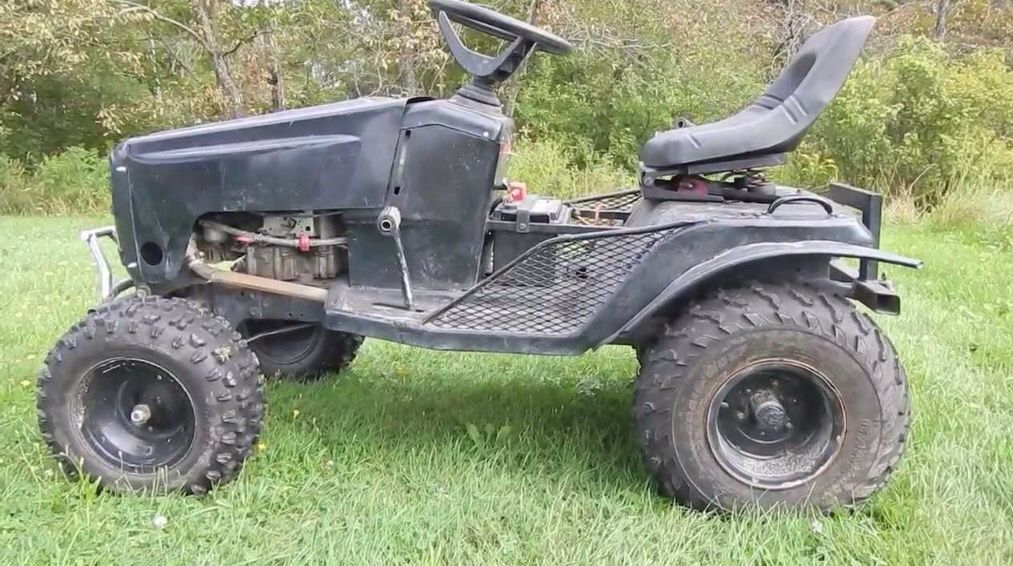
If one of your tires already has a bald spot, then you still need to get a replacement for it. Again, the best practice for ATV tires is to replace all tires or at least one set to give you the grip you want.
It’s normal for ATV tires to get bald spots, but one of the easiest ways to avoid—or at least delay—the balding of tires is by rotating them.
Pressure on tires can create bald spots, and if you’re using your ATV regularly, these spots will be uneven. Uneven tires can make you feel uneasy while riding, and it can cause injuries.
If you hear a humming or thumping sound while you’re riding, and it comes with a drastic decrease in your ATVs speed, it’s a good sign that you already need a replacement.
Both of these sounds mean that there’s something wrong with your tires, and using them on the tracks may be dangerous for you.
If you’d like to try and make your tires still work, you can also try rotating them. Sometimes, it’s enough to fix the problem, but if not, don’t delay the replacement.
If you do need to change your ATV tires, check out our articles:
In a perfect world, we should replace tires after every ride. But we all know that’s not possible. In fact, we want to make our tires last longer than we should and squeeze every mile possible out of them.
So, to help you with it, here are some things that you can do to make your ATV tires last longer:
 Sure, it’s impossible to avoid direct sunlight, but minimizing your tires’ exposure to it can help you prolong them. You may also want to consider using tire protectants that creates an added layer of protection for your tires.
Sure, it’s impossible to avoid direct sunlight, but minimizing your tires’ exposure to it can help you prolong them. You may also want to consider using tire protectants that creates an added layer of protection for your tires.Checking the tires is one of the crucial steps you need to take before you ride any vehicle, and it applies to ATVs as well.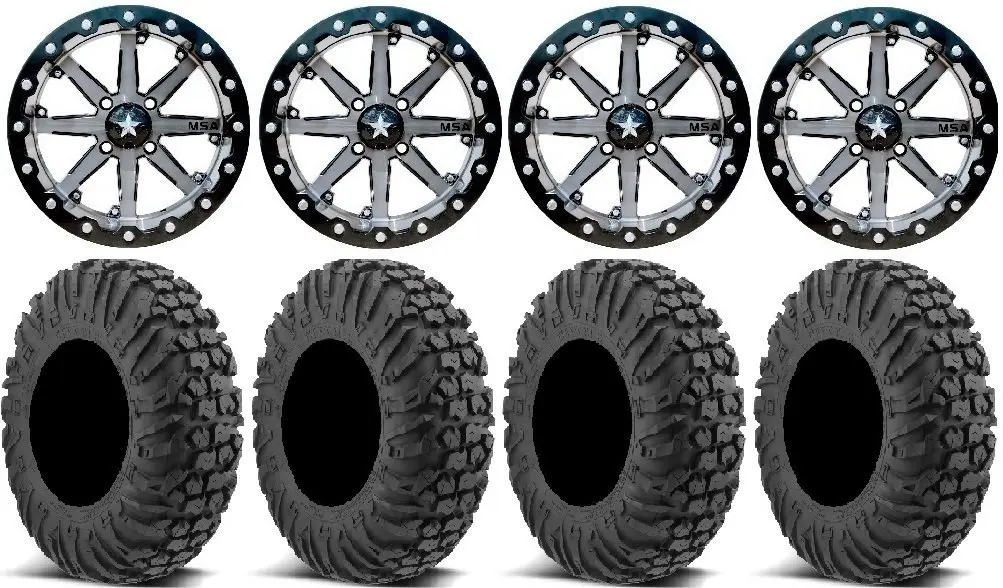 In fact, it’s even more important for ATVs because their tires don’t have an expiration date or recommended mileage before replacing.
In fact, it’s even more important for ATVs because their tires don’t have an expiration date or recommended mileage before replacing.
The signs that we shared with you are some of the most important things that every rider should learn because it makes the ride safer. Now that you know all of them, you can hit the tracks and easily spot problems with your tires and determine whether you already need a replacement or not.
Sharing is caring!
Have you ever thought about exactly how long do tires last, and how to find out date codes? Then you have come to the right place. I will tell you how you can find it out.
On ATV tires, you can find the date of tires by looking inside or outside of the tires. You want to be looking at four-digit and “DOT” at the front of it. The first two letters indicate in four-digit tell you which week it was produced, and the two last tell you what year it was made.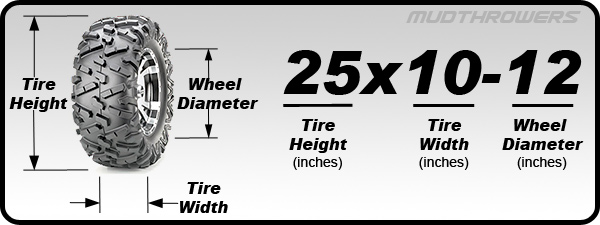
Finding it may be easy, but what if “DOT” doesn’t stand there or how long do you know when the time is to replace new tires. To learn more in detail, keep on reading, and I will tell you how to find out.
Table of Contents
The date codes are stamped on the tires which tell us when it was manufactured. You may wonder why tires don’t have any expiration date. There are several reasons for it:
Driver usage: If the driver is driving their ATV daily, the chances are the lifespan of the tires won’t last longer than those that are using one or two times at the weekend.
Climate: Temperature affects tires’ performance and their lifespan as well. In a dry condition, the tires won’t last longer than tires that are used in a moist climate.
Trail: Riding off-road, climbing up a hill requires a lot of power, but good traction from the wheels. This pushes the tires harder, and more of the rubber is stretched and worn out tread pattern.
Storing in open light: Try to avoid any sun-light (UV-ray) since it will be damaging tires in two ways. 1. It will increase the temperature (since rubber absorbs the UV-ray) and accelerate the aging progress.
The sunlight contains ultraviolet that affects the structure of the rubber which weakening strength and cause cracks (making it more brittle).
These are some of the factors that decide on how long tires would last, and therefore it’s unpredictable to say how long they last.
Manufactures recommend swapping the old ones out after 6 or 10 years old. However, this depends on many factors like driver usage, climate, aggressively driving, and trail you ride.
In hot climates like (Amazon, Minnesota, Nevada, and Florida), you should replace tires within 6 years, and the limit for 10 years in cold climates like (Michigan, Minnesota, Nord-Dakota, Maine, and Wisconsin).
Since tires don’t have any expiration date, you need to look on the condition tires by yourself.
Sign of when you should replace tires
In short answer, you might want to replace your tires every 3-4 months if you usually riding 3 hours weekly. Still, it would help if you inspected the tires to see whenever you need to change earlier or later on depending on the threat pattern.
The first thing we often do is looking at the tread pattern. If there aren’t almost anything left on the tires. You might want to replace a new one since the old would start losing grips while riding.
The other thing you need to look at is the side of the tires. If there are cracks on the side, it means the tires are old and could potentially be dangerous riding around with it.
Within the current year, you shouldn’t purchase tires that are older than 5 years.
As I mentioned earlier, the date code doesn’t matter as much. What we need to pay attention to is increase the life of the tires. There are many ways on how you can do it, but I want to give you simple tips that only takes a couple of minutes to do.
Protect tires from sunlight or high temperatures
Keep Tires in a cool place and dry to reduce deterioration
Avoid moisture or humidity place since it can compromise the tires
Avoid tires from freezing when temperatures drop
If you find tires that have a four-digit and “DOT” in front of the number, it means the tires have been produced since the year 2000. Luckily, The NTSB regulations don’t allow dealerships to sell tires that are older than 7 years, even if the tires haven’t been sold.
Despite being told, it’s not a bad idea to check the date code to ensure you buying the right ones.
For many of us might think buying tires that are produced within the year is the best. However, this isn’t the case. Many tires are created in other country. These may sometimes take time before it arrives in the United States from the manufacturer.
As long as the tires have been stored in a controlled environment, they are in excellent condition, despite the fact that Date code is a couple of years old. Try to avoid buying tires that are older than 5 years old. The ideal tires you would be looking for are tires that are produced under 2 years.
Try to avoid buying tires that are older than 5 years old. The ideal tires you would be looking for are tires that are produced under 2 years.
If you were looking for a new pair set of tires and suddenly saw it doesn’t have DOT stamped on the tires, it means they are not street legal.
They are not designed to use on hard surface because they only use low air pressure which makes them unsafe on the street road.
DOT stands for Department of Transportation, if your tires have a stamped, it means the tire manufacturer’s compliance with them. These tires have been tested, inspected and approved to use on the road.
It may be hard to find the DOT code since there are no regulation on how to place the DOT code. You may need to look at it several times on the sides before you find the numbers.
Usually, the “DOT” and numbers are on the backside, very close to the bead. The DOT number only appears on one side.
If you have purchase tires that don’t have the letters “DOT”, return it back to where you bought them.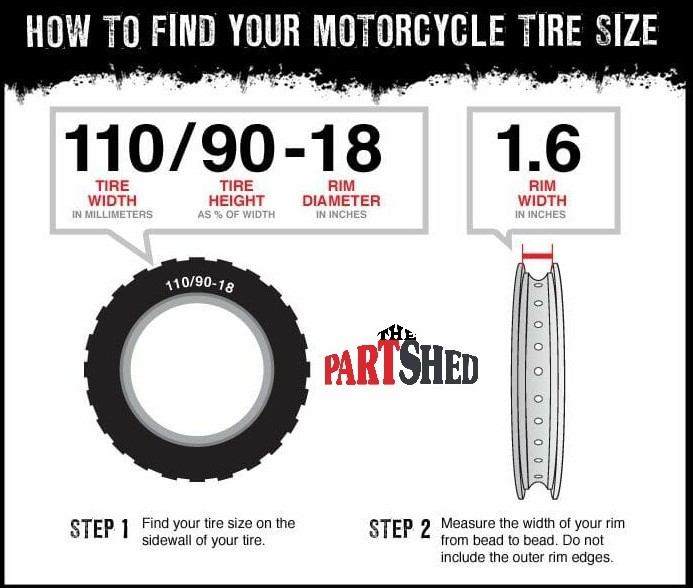 This isn’t acceptable to sell tires without any safety approval on them (if you plan on driving on the road).
This isn’t acceptable to sell tires without any safety approval on them (if you plan on driving on the road).
The other reason it doesn’t have “DOT” it may be dangerous riding with these tires.
Do you want to find out which tire is compatible with your rim, I have a post about it, click here to learn more.
Yes, as the rubber age, the harder it will get. Old tires are dangerous since the material isn’t stretchy and strong as it used to, which can cause unexpected tread separation.
This doesn’t happen often, but if you were not driving or let the tires aging over several years, there may be a chance it could occur.
Inspect the condition of the tires by searching for cracks or by poking with your fingernail.
When feeling the tires, you will notice with your finger whenever the tread of the tire is soft or hard. Older rubber are easier to crack compared to newer ones.
The older tires are hard, which makes it more difficult to get grip. Newer ones are stronger and stretch, making it easier to get grip.
Newer ones are stronger and stretch, making it easier to get grip.
Getting balanced on tires is optional. The purpose of balancing is to reduce any vibration between the rim and tires. Some vibration is too small to notice which makes sense why you don’t need it.
They may look like the same size, but they are not the same. To ensure that they are compatible to your vehicle, always check the letters on the tires.
05/17/2018
The numbers written on the side of the rubber tire can tell the owner of the ATV everything that interests him. And if you are for some If you don't know what these mysterious numbers mean, then you can be mistaken when choosing the next set of tires. But tires directly determine whether it will go technique further or not. So, in this article you will close all the questions on about the decoding of size ATV tire .
All tires have their own basic parameters - this is the width, height and diameter. The value of these parameters is mainly measured in inches. Exist two units:
1) If you have ATV, then this is for you. English version is the most common number system that is used when determination of tire dimensions on ATVs. All measurements here are in inches. (1 inch equals 2.54 cm). For example, the size indicated in English classification looks like this - 25x8x12 . Let's take a closer look at the meaning of each digit:
- The first digit 25 shows the height of the tire in inches;
- The second digit 8 indicates the width of the tire in inches;
- The last, third digit 12 indicates the diameter of the wheel disk, it is also measured in inches. Disc diameter on each ATV can be different. Therefore, be careful before you buy tires for ATV, see what regular disks are installed on your vehicle. nine0004
nine0004
And a very important point worth noting. Often our customers ask themselves: “If I have a tire size of 20x10x10, can I put instead of them 20x11x10? The answer is yes. First, you can put rubber on regular wheels with a size exceeding 1 inch in height and width. Secondly, if you want tires even wider, then for this you will need to buy other disks. But again, there are limitations. On discs of other diameters, you can install rubber, the largest is only 2 inches in height and width. nine0004
These two rules must be strictly observed, otherwise, if you try to put tires of an unacceptably large size, this may adversely affect on a quad bike. After all, the rubber will be larger and, accordingly, heavier, which does not fit the technical parameters of the ATV. In production ATVs take into account all the characteristics, so manufacturers of ATV equipment I don't recommend using larger tires at all. But if you do decided to increase the size of tires, call our toll-free number, we we will help. nine0004
nine0004
2) Also there is another version - metric . Here the dimensions are indicated in percentage and millimeters. For example, size specified according to the metric classification - 205/80 Rx12 . Such designations are usually used on automobile tires. Let's see what's what:
- The first digit of 205 shows the total tire width in millimeters. Converting this value to inches, we will just get the number 8 (in the English version is 8 inches wide). nine0004
- The second digit 80 indicates the ratio of the height of the tire to its width, measured as a percentage. After doing some mathematical manipulations, we get the number 25 (in the English version, the height is equal to 25 inches).
- The number 12, as in the English version, shows the size disk in inches.
- Well, the letter R means that our tire is radial.
The most important thing to remember from the article is that it is not recommended to install tires of huge sizes that do not correspond to the parameters your ATV . If you want to change the tires on your vehicle, give us a call. we will help.
If you want to change the tires on your vehicle, give us a call. we will help.
05/11/2014
In the ATV world, the tire marking system is in inches. For example, let's deal with the size of rubber 27x9x12
"27" - the first number in the row will be the wheel diameter in inches. It is worth recalling that 1 inch is equal to 2.54 cm. This marking system is very convenient in that it indicates the diameter of the wheel, taking into account the size of the rim. For example, a wheel marked 27x9x12 will not differ in diameter from a wheel marked 27x9x14, just a 14-inch wheel will be 2.5 cm smaller.
"9" - the second value gives an indication of the width of the tire and is also expressed in inches.
"12" - The diameter of the disc on which the tire is mounted.
Tread pattern
1. Universal tyres.
ATV tire with this tread has a shallow but aggressive tread pattern.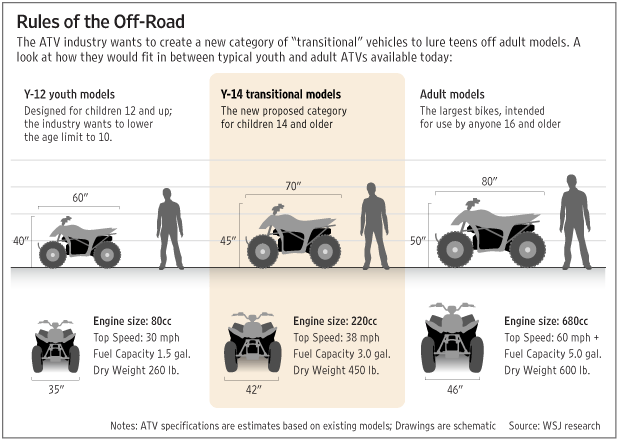 Such rubber behaves very well on dry soils, forest rolled paths, primers. It is used in mountainous suitability (stones, crushed stone). She has excellent performance on sand and loose soils. In mud or swampy areas, such rubber rides no worse than mud. She does not burrow and confidently storms the swamps, if the gas is dosed correctly. It does not need to be “pulled in” like mud tires, you need to work with gas correctly and try to go through difficult sections “on the move”. Universal rubber, always lighter and softer than mud. It's much more comfortable to ride and handling is better. The height of the lugs for universal rubber should be at least 20 mm, the distance between them should be at least 20 mm and not more than 30 mm. The shape of the lugs (pyramid) and the distance between them provide good self-cleaning. The standard tires of many ATVs do not fit the description of universal rubber, mainly because of the small tread height. nine0004
Such rubber behaves very well on dry soils, forest rolled paths, primers. It is used in mountainous suitability (stones, crushed stone). She has excellent performance on sand and loose soils. In mud or swampy areas, such rubber rides no worse than mud. She does not burrow and confidently storms the swamps, if the gas is dosed correctly. It does not need to be “pulled in” like mud tires, you need to work with gas correctly and try to go through difficult sections “on the move”. Universal rubber, always lighter and softer than mud. It's much more comfortable to ride and handling is better. The height of the lugs for universal rubber should be at least 20 mm, the distance between them should be at least 20 mm and not more than 30 mm. The shape of the lugs (pyramid) and the distance between them provide good self-cleaning. The standard tires of many ATVs do not fit the description of universal rubber, mainly because of the small tread height. nine0004
2. Mud tires.
Mud tires have an aggressive tread consisting of large blocks and a large distance between them. These tires are specially designed for heavy off-road driving. Typically, the tread of mud tires has a herringbone pattern. Such a pattern behaves well in muddy mud, a swamp and contributes to good self-cleaning. When driving on loose soils, you need to be careful, since such a tire instantly digs in when slipping. The tread height of mud tires is from 25mm to 30mm. The distance between the central lugs can be up to 100mm depending on the tire size. There are exotic tires with a tread height of 50mm. Such large lug spacing seriously reduces ATV handling on hard and loose ground. In addition, mud tires are always hard, which makes driving on hard ground uncomfortable. Mud tires weigh much more than universal ones. If tires of the same size are weighed, then universal tires weigh almost 20% less
These tires are specially designed for heavy off-road driving. Typically, the tread of mud tires has a herringbone pattern. Such a pattern behaves well in muddy mud, a swamp and contributes to good self-cleaning. When driving on loose soils, you need to be careful, since such a tire instantly digs in when slipping. The tread height of mud tires is from 25mm to 30mm. The distance between the central lugs can be up to 100mm depending on the tire size. There are exotic tires with a tread height of 50mm. Such large lug spacing seriously reduces ATV handling on hard and loose ground. In addition, mud tires are always hard, which makes driving on hard ground uncomfortable. Mud tires weigh much more than universal ones. If tires of the same size are weighed, then universal tires weigh almost 20% less
3. Tire pressure.
All ATV tires are low pressure tires. On average, for normal driving, tire pressure should be maintained between 6 and 8 psi. If you intend to use the ATV only in swampy areas, then the pressure must be reduced.